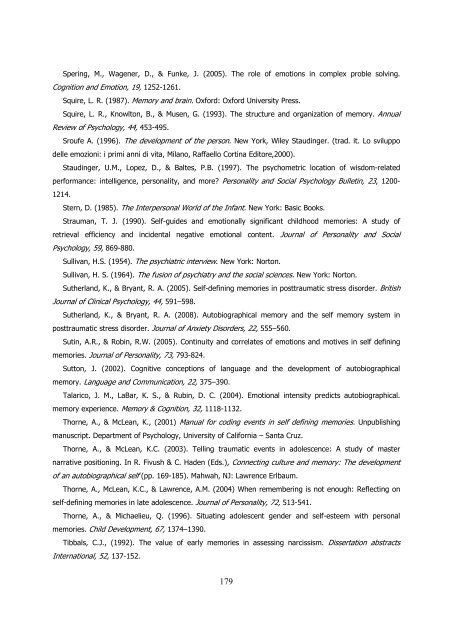LA NARRAZIONE AUTOBIOGRAFICA E IL FUNZIONAMENTO DEL SÉ
LA NARRAZIONE AUTOBIOGRAFICA E IL FUNZIONAMENTO DEL SÉ
LA NARRAZIONE AUTOBIOGRAFICA E IL FUNZIONAMENTO DEL SÉ
Create successful ePaper yourself
Turn your PDF publications into a flip-book with our unique Google optimized e-Paper software.
Spering, M., Wagener, D., & Funke, J. (2005). The role of emotions in complex proble solving.<br />
Cognition and Emotion, 19, 1252-1261.<br />
Squire, L. R. (1987). Memory and brain. Oxford: Oxford University Press.<br />
Squire, L. R., Knowlton, B., & Musen, G. (1993). The structure and organization of memory. Annual<br />
Review of Psychology, 44, 453-495.<br />
Sroufe A. (1996). The development of the person. New York, Wiley Staudinger. (trad. it. Lo sviluppo<br />
delle emozioni: i primi anni di vita, Milano, Raffaello Cortina Editore,2000).<br />
Staudinger, U.M., Lopez, D., & Baltes, P.B. (1997). The psychometric location of wisdom-related<br />
performance: intelligence, personality, and more? Personality and Social Psychology Bulletin, 23, 1200-<br />
1214.<br />
Stern, D. (1985). The Interpersonal World of the Infant. New York: Basic Books.<br />
Strauman, T. J. (1990). Self-guides and emotionally significant childhood memories: A study of<br />
retrieval efficiency and incidental negative emotional content. Journal of Personality and Social<br />
Psychology, 59, 869-880.<br />
Sullivan, H.S. (1954). The psychiatric interview. New York: Norton.<br />
Sullivan, H. S. (1964). The fusion of psychiatry and the social sciences. New York: Norton.<br />
Sutherland, K., & Bryant, R. A. (2005). Self-defining memories in posttraumatic stress disorder. British<br />
Journal of Clinical Psychology, 44, 591–598.<br />
Sutherland, K., & Bryant, R. A. (2008). Autobiographical memory and the self memory system in<br />
posttraumatic stress disorder. Journal of Anxiety Disorders, 22, 555–560.<br />
Sutin, A.R., & Robin, R.W. (2005). Continuity and correlates of emotions and motives in self defining<br />
memories. Journal of Personality, 73, 793-824.<br />
Sutton, J. (2002). Cognitive conceptions of language and the development of autobiographical<br />
memory. Language and Communication, 22, 375–390.<br />
Talarico, J. M., LaBar, K. S., & Rubin, D. C. (2004). Emotional intensity predicts autobiographical.<br />
memory experience. Memory & Cognition, 32, 1118-1132.<br />
Thorne, A., & McLean, K., (2001) Manual for coding events in self defining memories. Unpublishing<br />
manuscript. Department of Psychology, University of California – Santa Cruz.<br />
Thorne, A., & McLean, K.C. (2003). Telling traumatic events in adolescence: A study of master<br />
narrative positioning. In R. Fivush & C. Haden (Eds.), Connecting culture and memory: The development<br />
of an autobiographical self (pp. 169-185). Mahwah, NJ: Lawrence Erlbaum.<br />
Thorne, A., McLean, K.C., & Lawrence, A.M. (2004) When remembering is not enough: Reflecting on<br />
self-defining memories in late adolescence. Journal of Personality, 72, 513-541.<br />
Thorne, A., & Michaelieu, Q. (1996). Situating adolescent gender and self-esteem with personal<br />
memories. Child Development, 67, 1374–1390.<br />
Tibbals, C.J., (1992). The value of early memories in assessing narcissism. Dissertation abstracts<br />
International, 52, 137-152.<br />
179

















